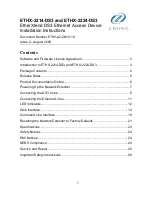
To change the parameters of all ports in an EtherChannel, change the configuration of the port-channel
interface; for example, if you want to configure Spanning Tree Protocol or configure a Layer 2 EtherChannel
as a trunk. Any configuration or attribute changes you make to the port-channel interface are propagated to
all interfaces within the same channel group as the port-channel; that is, configuration changes are propagated
to the physical interfaces that are not part of the port-channel but are part of the channel group.
The configuration of a LAN port affects only that LAN port.
IEEE 802.3ad Link Bundling
The IEEE 802.3ad Link Bundling feature provides a method for aggregating multiple Ethernet links into a
single logical channel based on the IEEE 802.3ad standard. This feature helps improve the cost effectiveness
of a device by increasing cumulative bandwidth without necessarily requiring hardware upgrades. In addition,
IEEE 802.3ad Link Bundling provides a capability to dynamically provision, manage, and monitor various
aggregated links and enables interoperability between various Cisco devices and devices of third-party vendors.
LACP supports the automatic creation of EtherChannels by exchanging LACP packets between LAN ports.
LACP packets are exchanged only between ports in passive and active modes. The protocol
“
learns
”
the
capabilities of LAN port groups dynamically and informs the other LAN ports. After LACP identifies correctly
matched Ethernet links, it facilitates grouping the links into an EtherChannel. Then the EtherChannel is added
to the spanning tree as a single bridge port.
Both the passive and active modes allow LACP to negotiate between LAN ports to determine if they can form
an EtherChannel, based on criteria such as port speed and trunking state. (Layer 2 EtherChannels also use
VLAN numbers.) LAN ports can form an EtherChannel when they are in compatible LACP modes, as in the
following examples:
•
A LAN port in active mode can form an EtherChannel with another LAN port that is in active mode.
•
A LAN port in active mode can form an EtherChannel with another LAN port in passive mode.
•
A LAN port in passive mode cannot form an EtherChannel with another LAN port that is also in passive
mode because neither port will initiate negotiation.
LACP uses the following parameters:
•
LACP system priority
—
You must configure an LACP system priority on each device running LACP.
The system priority can be configured automatically or through the command-line interface (CLI). LACP
uses the system priority with the device MAC address to form the system ID and also during negotiation
with other systems.
•
LACP port priority
—
You must configure an LACP port priority on each port configured to use LACP.
The port priority can be configured automatically or through the CLI. LACP uses the port priority to
decide which ports should be put in standby mode when there is a hardware limitation that prevents all
compatible ports from aggregating. LACP also uses the port priority with the port number to form the
port identifier.
•
LACP administrative key
—
LACP automatically configures an administrative key value on each port
configured to use LACP. The administrative key defines the ability of a port to aggregate with other
ports. A port
’
s ability to aggregate with other ports is determined by the following:
•
Port physical characteristics such as data rate, duplex capability, and point-to-point or shared
medium
•
Configuration restrictions that you establish
Carrier Ethernet Configuration Guide (Cisco ASR 920 Series)
351
Configuring IEEE 802.3ad Link Bundling
IEEE 802.3ad Link Bundling
















































